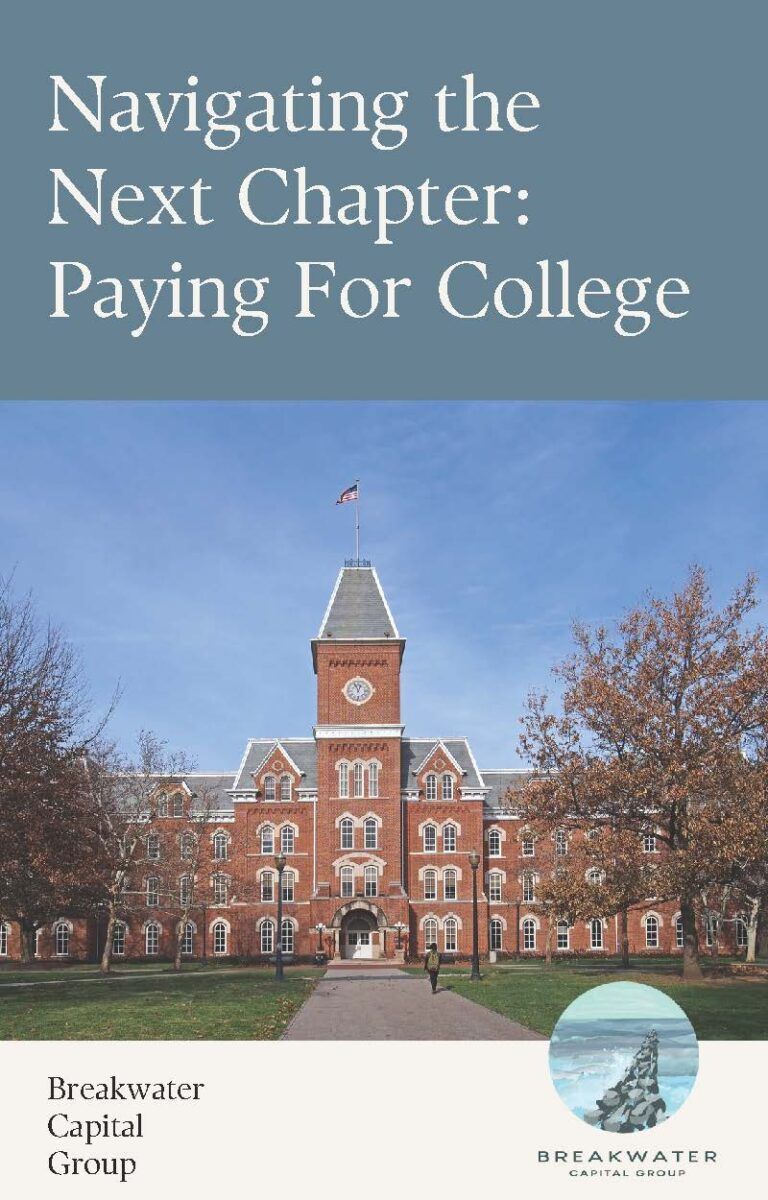Preparing for College Costs: A Guide for Massachusetts Parents

Every parent wants to give their child the best opportunities in life, and a quality education is a key part of that. However, with college costs rising rapidly, planning ahead has never been more important.
Over the past 20 years, tuition and fees at public four-year institutions have more than doubled, making it essential for families to explore various options and develop a savings strategy.
At Breakwater Capital Group, our Greater Boston based wealth management team works with individuals and families nationwide to develop financial plans that incorporate college savings while keeping other financial priorities on track.
This guide discusses the rising cost of college, available financial aid, and practical strategies to help Greater Boston parents prepare.
The High Cost of College
College expenses extend beyond tuition, making it necessary to factor in the full cost of attendance. The primary components include:
- Tuition and fees – The direct cost of attending classes varies based on in-state vs. out-of-state status.
- Room and board – Housing and meal expenses, whether living on or off campus.
- Books and supplies – The cost of required textbooks, lab fees, and school supplies.
- Personal expenses and transportation – Additional costs include travel, healthcare, and everyday living expenses.
Understanding these costs is the first step in building your financial strategy for higher education. Breakwater’s fee-only financial planner in Greater Boston can assess your situation and offer strategies to help you plan for your child’s education.
Financial Aid Options for Greater Boston Families
Paying for college doesn’t have to fall entirely on savings. Financial aid options can help offset costs, making education more affordable. Here are key sources of financial assistance available to students:
- Grants and scholarships – Unlike loans, grants and scholarships do not need to be repaid. Federal Pell Grants, state grants, and private scholarships from nonprofit organizations or businesses can provide significant financial relief.
- Work-study programs – The Federal Work-Study Program offers part-time jobs for students with financial need, allowing them to earn money while attending school.
- Federal and private loans – Federal student loans generally offer lower interest rates and more flexible repayment options compared to private loans. Subsidized loans do not accrue interest while the student is in school, making them a better borrowing option when necessary.
- FAFSA (Free Application for Federal Student Aid) – The FAFSA is essential for determining eligibility for federal aid, state grants, and institutional scholarships. It’s wise to complete this application early to maximize available funding.
Before taking on student loans, explore all financial aid options. Combining aid with a solid savings plan can help reduce out-of-pocket expenses.
College Saving Strategies
While much emphasis has been placed on the Central Bank’s decision around interest rate policy, the vast majority of investors have exposure to bonds of differing credit quality and duration. While the Federal Reserve controls the overnight rate, impacting securities like money market funds and Certificates of Deposit, longer term rates are influenced by growth and inflation expectations along with the odds of repayment by the borrower.
Historically the direction of monetary policy does have some impact on longer term rates, but the relationship itself has seen varying levels of influence through different economic cycles. All the more reason to embrace diversification here much like investors do with the equity portion of their portfolios.
Impact of Rising Interest Rates on Income Generation
Specific savings tools offer investment growth and tax advantages for education expenses. Here are key options for Colorado families.
529 College Savings Plans – Colorado’s CollegeInvest 529 Plan offers tax-free growth on earnings when used for qualified education expenses. For the 2025 tax year, contributions are fully deductible from Colorado state income tax up to $25,400 per beneficiary for single filers and $38,100 for joint filers. The maximum total balance per beneficiary is $500,000, beyond which no further contributions can be made.
Coverdell Education Savings Accounts (ESAs) – These accounts allow tax-free withdrawals for education-related expenses but have a $2,000 annual contribution limit per beneficiary. Contribution eligibility is income-based, with phaseouts starting at $95,000 for single filers and $190,000 for joint filers.
UTMA/UGMA accounts – While not exclusively for college savings, these custodial accounts allow parents to save on behalf of their children. However, since the assets belong to the child, they may reduce financial aid eligibility under FAFSA calculations.
Retirement accounts – Some parents consider withdrawing from 401(k)s or IRAs to cover college costs, but this should be done carefully. Traditional IRA withdrawals for qualified education expenses are exempt from the 10% early withdrawal penalty, though they are still subject to income tax.
Roth IRA contributions (but not earnings) can be withdrawn tax-free at any time, and earnings may be used for education if the account is at least five years old, avoiding the 10% penalty. However, withdrawals from retirement accounts can count as income on the FAFSA, potentially reducing financial aid eligibility.
For Colorado families, working with Breakwater’s Greater Boston financial advisor can help select the right savings strategy while balancing other financial goals.
Additional Considerations for Greater Boston Parents
Beyond tuition, several factors can influence the total cost of a college education. Consider how location, family circumstances, and financial priorities affect overall expenses.
- In-state vs. out-of-state tuition – Attending a public university in Colorado is typically more affordable than out-of-state options. The Western Undergraduate Exchange (WUE) program offers reduced tuition for Colorado residents at participating schools in 16 Western states.
- Multiple children in college – Financial aid calculations can change when more than one child is enrolled at the same time. Families may qualify for additional need-based aid during these years, making it vital to update FAFSA applications annually.
- Balancing college and retirement savings – Parents often prioritize college savings, but it’s important not to overlook retirement. Unlike college expenses, there are no loans available for retirement, making it crucial to strike a balance between saving for both.
College planning is just one piece of your broader financial strategy. Reviewing education costs alongside long-term goals, Breakwater’s retirement planning advisors in Greater Boston can help you make well-informed financial decisions.
Partner With Breakwater’s Massachusetts Wealth Management Team
Breakwater’s Greater Boston financial planning team is part of a group of professionals with over 50 years of experience. In addition to our Greater Boston wealth management advisors, our firm serves clients across the U.S. through our Denver, CO, financial planning and financial planning Paramus, NJ, offices.
We help families navigate the complexities of paying for college by offering:
- College funding strategies – Identifying the best savings vehicles and financial aid options.
- Tax-efficient investment planning – Helping parents position assets to maximize savings potential.
- Comprehensive financial planning – Balancing education costs with retirement and other financial goals.
Reach out to us today to schedule a consultation and build a plan to manage college expenses while maintaining focus on your financial future.

The views expressed represent the opinions of Breakwater Capital Group as of the date noted and are subject to change. These views are not intended as a forecast, a guarantee of future results, investment recommendation, or an offer to buy or sell any securities. The information provided is of a general nature and should not be construed as investment advice or to provide any investment, tax, financial or legal advice or service to any person. The information contained has been compiled from sources deemed reliable, yet accuracy is not guaranteed.
Additional information, including management fees and expenses, is provided on our Form ADV Part 2 available upon request or at the SEC’s Investment Adviser Public Disclosure website, www.adviserinfo.sec.gov. Past performance is not a guarantee of future results.

Breakwater Team
At Breakwater Capital, we work with families across the United States, providing each client with a personalized experience tailored to their current circumstances, future goals, and timelines.











